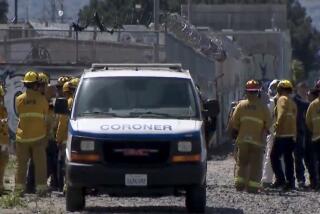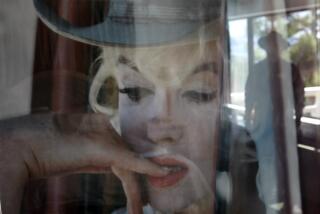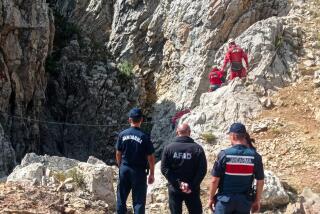Refusing to Cave In : Concrete Solution to Dispute Over Personal Sanctuary
- Share via
For almost two decades, Nick Connell’s secluded man-made cave within the Torrey Pines State Reserve has been a stony sanctuary for a private little man who wanted to write a philosophy book that would change the world.
During wintertime trips to San Diego from his New Hampshire home, Connell used only a screwdriver, Bowie knife and pickax to hew the cave from a sheer cliff wall. Over time, he fashioned the elaborate domed ceilings, a window, bed space and bookshelves into the two-room cavern he came to call his artist’s retreat.
In recent years, the 69-year-old philosopher and ex-circus performer also made the tiny 6-foot-high cave a sort of spiritual shrine, adorning its walls with colorful renditions of religious figures--Biblical and Mayan characters, Egyptian Pharaohs, griffins, lions and avenging angels.
Eventually, people around the state park who had visited “Nick’s Cave” came up with a nickname for the seldom-seen Connell as well. They called him the Hermit of Torrey Pines.
“When I was a kid, I always envisioned myself as a hermit and I never lost that ambition,” Connell said during a recent visit to the cave, just east of North Torrey Pines Road. “So I built a cave where I could surround myself with art and write a book about what life is all about.
“But once the cave was finished, I realized that I had created something really spiritual. There is something holy about this place.”
Park rangers agree that the cave was an artistic piece of work. Earlier this month, however, they filled the cavity nearly to the brim with concrete, sealing off Connell’s cavern along with three year’s worth of cave paintings.
Authorities say the cavern had become an attractive nuisance that lured curious onlookers who threatened the fragile habitat in an area restricted from public use. And they fear liability for injuries to people attempting to descend the cliff wall to reach the cave.
Connell admits that damage was indeed done by countless hikers who tramped along the rugged trail he built to his cave. But with a small amount of work, he says, the trail could have been improved to protect the nearby habitat.
But all that is lost now, Connell says. Last week, he contacted the American Civil Liberties Union and now plans to sue the state for violating his civil rights by not allowing him to remove his artwork before the cave was destroyed. The ACLU is considering Connell’s request.
Rangers say Connell doesn’t have a legal leg to stand on.
“I was very impressed with what Nick Connell was able to accomplish with that cave,” said Robert Wohl, supervising ranger for the Torrey Pines State Reserve. “But Nick also broke a lot of laws along the way.
“This reserve is home to the rarest pine tree in the state and the third rarest in the world. And a little piece of this place is no longer the pristine habitat it once was thanks to Nick Connell and his cave.”
Joan Jackson, a local Sierra Club spokeswoman, agreed that Connell had taken his back-to-nature attempts too far.
“All Americans are naturally drawn to such independence,” she said. “It’s the stuff of Thoreau. This rugged back-to-nature stuff is fine. But not in a state park. Those bluffs are extremely fragile. And it doesn’t appear as though this man respected that.”
Connell acknowledges the land wasn’t his. But the paintings destroyed certainly were, he says. And he should have been allowed to save them.
“There was something worthwhile in that cave, artifacts with cultural and religious value,” he said. “The authorities claim it attracted a lot of undesirables, young kids looking for trouble.
“Well, the hundreds of young people who visited the inside of that cave treated it with respect. The only vandalism was done by the park authorities themselves.”
Connell isn’t the only one upset with the demise of Nick’s Cave. Scores of people back in his hometown of Hudson, N.H., aren’t too pleased either, says Fidele Bernasconi.
“They’ve destroyed a thinking man’s hide-out,” said the publisher of the Hudson News, a 10,000-circulation weekly in the tiny New England town. “I mean, Einstein had his laboratory and Edison had his electricity. Well, Nick Connell had his cave. He’s a Renaissance man who needed a place to work. What harm could he have possibly done?”
Andrew Renzullo, a vice president of the paper, called Connell a respected local citizen who had amazed townsfolk with stories of his California cave.
Connell, he said, is a board member of the local historical society who contributed a regular column he called “A View from the Cave” including anecdotes about cave visitors and about the winter months he spent in Southern California.
“Nick Connell is no crackpot,” Renzullo said. “He’s a respected member of our community. And he’s a man to be reckoned with.”
Several years ago, Renzullo said, Connell took Hudson police to court for allegedly violating his right to photograph the scene of a traffic accident from a private residence. He won the case.
“Folks around here know Nick and his cave,” Bernasconi said. “I was supposed to visit him there soon. Now I guess I’ll never get to see it.”
The idea for a cave, Connell said, was one that had been growing for years. A high school dropout, he had spent his life knocking around in various jobs. He was a railroad worker and, for a short time, a vaudeville performer and auxiliary policeman.
For several years, he was also a trapeze artist and once worked with the elephant act with the Ringling Bros. circus.
Connell recalled being on a Greyhound bus trip between Los Angeles and San Diego when he first set eyes on his cave site.
“The time had come to build a sanctuary for myself,” he said. “I was interested in researching art and archeology and I could smell the antiquity of the place.”
And so that winter of 1971, Connell used rudimentary tools to begin fashioning his cave from the sheer sandstone wall. Come spring, he returned to the circus. When the next winter rolled around, he picked up where he left off with the cave project.
All the while, Connell said, the cave remained a secret from park rangers.
That changed in 1988, however, when San Diego police investigators probing a nearby homicide happened upon the cavern and notified park officials.
“The police had to rappel down that steep slope just to find the thing,” said park ranger Wohl. “Then we found that Nick had built this goat’s trail down there and had even installed wooden steps in the trickier parts.”
“We went around with Nick for years on this thing. We told him we wouldn’t destroy the cave as long as he kept his promise to stay away from the place and not to encourage others to come there. But Nick went back on his word.”
Connell remembers things differently. He recalls that park officials vowed never to destory his cave. “Since I had their promise it was something to last forever, I decided to go ahead and do things right.”
So Connell decorated the walls with splashy images of the figures he’d stumbled across in his studies. On numerous coats of water-based Latex paint, he used colorful acrylics to paint characters from ancient Egypt, Assyria, Greece, Rome and Mesopotamia.
Outside, he sketched a bas-relief interpretation of a Syrian winged bull. And he left a guest book for visitors to sign their names.
Meanwhile, word spread among local hikers that somewhere within the 1,000-acre park a funny little man had set up shop in his vacation hideaway. People began looking for Connell and his cave.
“We had people from Europe and Asia here,” Connell recalled. “One night, a firefighter in full gear found the cave while investigating an accident nearby. The next day, he brought back his fellow firemen to see it.
“But I’ll admit that it sort of started to get out of hand. Last April, the guest book had more than 300 names in it.”
Dave Dreyer of Oceanside was one of the locals to visit the cave. “I was absolutely dumbfounded when I saw it,” he said. “The man truly is an artist. What he made deserved to be preserved.
“But his cave just became too popular. That was its undoing.”
Meanwhile, Connell has appealed to authorities about the treatment of his cave. Last year, he wrote several state politicians requesting legislation to protect his creation.
He has also sent materials to several local historical societies in the hope that someone will take an interest in his cause--so far, all to no avail.
So as winter turns to spring, Connell will remain in a hidden makeshift campsite in the Sorrento Valley, researching his Great American psychology novel and wondering what went wrong with Nick’s Cave.
“I just don’t understand it,” he said, peering into the mouth of the abandoned cavern. “I wanted it to be just for me.”
More to Read
Sign up for Essential California
The most important California stories and recommendations in your inbox every morning.
You may occasionally receive promotional content from the Los Angeles Times.











